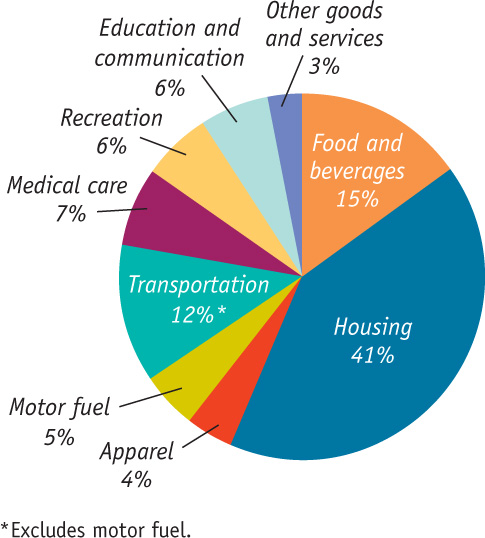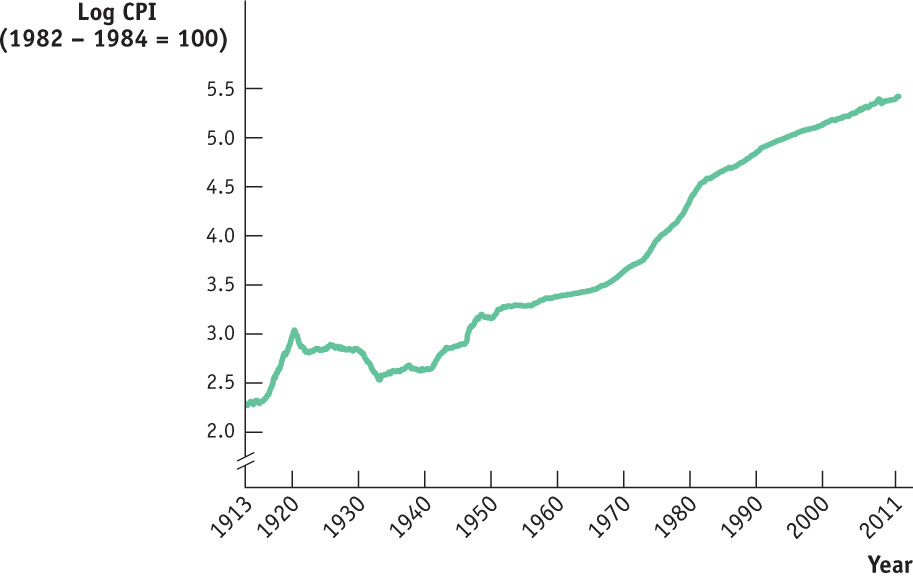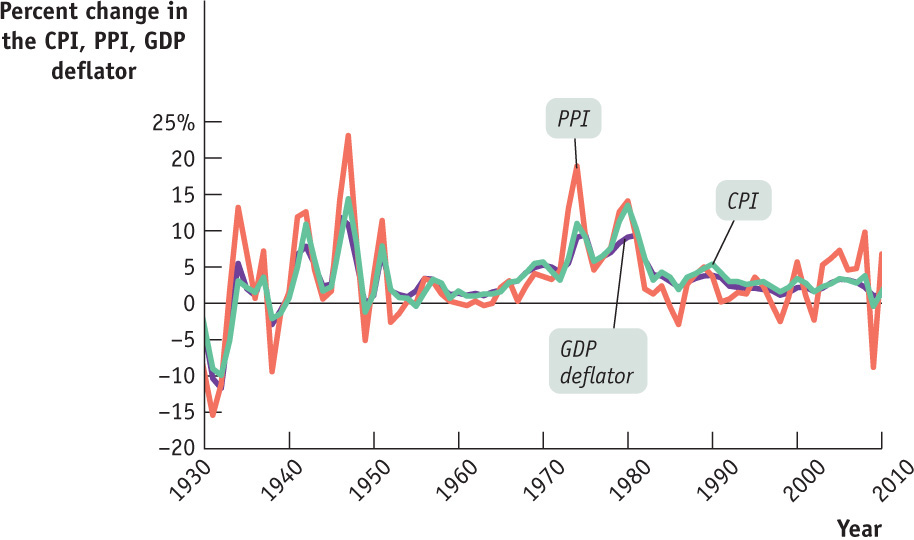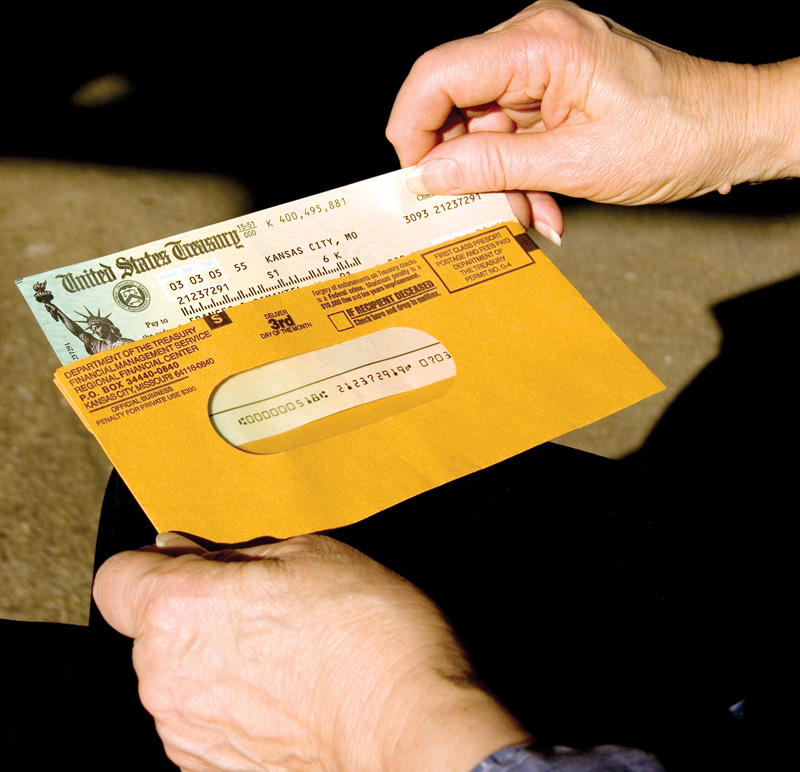Price Indexes and the Aggregate Price Level
In 2011 and 2012, Americans faced sticker shock at the gas pump: the price of a gallon of regular gasoline had risen from an average of $1.61 at the end of December 2008 to close to $4. Many other prices were also up. Some prices, like those for electronics, though, were heading down. Yet practically everyone felt that the overall cost of living was rising. But how fast?
The aggregate price level is a measure of the overall level of prices in the economy.
Clearly, there was a need for a single number summarizing what was happening to consumer prices. Just as macroeconomists find it useful to have a single number representing the overall level of output, they also find it useful to have a single number representing the overall level of prices: the aggregate price level. Yet a huge variety of goods and services are produced and consumed in the economy. How can we summarize the prices of all these goods and services with a single number? The answer lies in the concept of a price index—a concept best introduced with an example.
Market Baskets and Price Indexes
Suppose that a frost in Florida destroys most of the citrus harvest. As a result, the price of an orange rises from $0.20 each to $0.40, the price of grapefruit rises from $0.60 to $1.00, and the price of a lemon rises from $0.25 to $0.45. How much has the price of citrus fruit increased?
One way to answer that question is to state three numbers—the changes in prices for oranges, grapefruit, and lemons. But this is a very cumbersome method. Rather than having to recite three numbers in an effort to track changes in the prices of citrus fruit, we would prefer to have some kind of overall measure of the average price change.
A market basket is a hypothetical set of consumer purchases of goods and services.
To measure average price changes for consumer goods and services, economists track changes in the cost of a typical consumer’s consumption bundle—the typical basket of goods and services purchased before the price changes. A hypothetical consumption bundle, used to measure changes in the overall price level, is known as a market basket. Suppose that before the frost a typical consumer bought 200 oranges, 50 grapefruit, and 100 lemons over the course of a year, our market basket for this example.
Table 11-3 shows the pre-frost and post-frost cost of this market basket. Before the frost, it cost $95; after the frost, the same bundle of goods cost $175. Since $175/$95 = 1.842, the post-frost basket costs 1.842 times the cost of the pre-frost basket, a cost increase of 84.2%. In this example, the average price of citrus fruit has increased 84.2% since the base year as a result of the frost, where the base year is the initial year used in the measurement of the price change.
TABLE 11-3 Calculating the Cost of a Market Basket
| Pre-frost | Post-frost | |
|---|---|---|
| Price of orange | $0.20 | $0.40 |
| Price of grapefruit | 0.60 | 1.00 |
| Price of lemon | 0.25 | 0.45 |
| Cost of market basket(200 oranges, 50 grapefruit, 100 lemons) | (200 × $0.20) + (50 × $0.60) + (100 × $0.25) = $95.00 | (200 × $0.40) + (50 × $1.00) + (100 × $0.45) = $175.00 |
Economists use the same method to measure changes in the overall price level: they track changes in the cost of buying a given market basket. In addition, they perform another simplification in order to avoid having to keep track of the information that the market basket cost, for example, $95 in such-and-such a year. They normalize the measure of the aggregate price level, which means that they set the cost of the market basket equal to 100 in the chosen base year. Working with a market basket and a base year, and after performing normalization, we obtain what is known as a price index, a normalized measure of the overall price level. It is always cited along with the year for which the aggregate price level is being measured and the base year. A price index can be calculated using the following formula:

A price index measures the cost of purchasing a given market basket in a given year, where that cost is normalized so that it is equal to 100 in the selected base year.
In our example, the citrus fruit market basket cost $95 in the base year, the year before the frost. So by Equation 11-1 we define the price index for citrus fruit as (cost of market basket in current year/$95) × 100, yielding an index of 100 for the period before the frost and 184.2 after the frost. You should note that the price index for the base year always results in a price index equal to 100. This is because the price index in the base year is equal to: (cost of market basket in base year/cost of market basket in base year) × 100 = 100.
Thus, the price index makes it clear that the average price of citrus has risen 84.2% as a consequence of the frost. Because of its simplicity and intuitive appeal, the method we’ve just described is used to calculate a variety of price indexes to track average price changes among a variety of different groups of goods and services. For example, the consumer price index, which we’ll discuss shortly, is the most widely used measure of the aggregate price level, the overall price level of final consumer goods and services across the economy.
The inflation rate is the percent change per year in a price index—typically the consumer price index.
Price indexes are also the basis for measuring inflation. The inflation rate is the annual percent change in an official price index. The inflation rate from year 1 to year 2 is calculated using the following formula, where we assume that year 1 and year 2 are consecutive years.

Typically, a news report that cites “the inflation rate” is referring to the annual percent change in the consumer price index.
The Consumer Price Index
The consumer price index, or CPI, measures the cost of the market basket of a typical urban American family.
The most widely used measure of prices in the United States is the consumer price index (often referred to simply as the CPI), which is intended to show how the cost of all purchases by a typical urban family has changed over time. It is calculated by surveying market prices for a market basket that is constructed to represent the consumption of a typical family of four living in a typical American city. The base period for the index is currently 1982–1984; that is, the index is calculated so that the average of consumer prices in 1982–1984 is 100.
The market basket used to calculate the CPI is far more complex than the three-fruit market basket we described above. In fact, to calculate the CPI, the Bureau of Labor Statistics sends its employees out to survey supermarkets, gas stations, hardware stores, and so on—some 23,000 retail outlets in 87 cities. Every month it tabulates about 80,000 prices, on everything from romaine lettuce to a medical check-up. Figure 11-3 shows the weight of major categories in the consumer price index as of December 2011. For example, motor fuel, mainly gasoline, accounted for 5% of the CPI in December 2011. So when gas prices rose 150%, from about $1.61 a gallon in late 2008 to $3.96 a gallon in May 2011, the effect was to increase the CPI by about 1.5 times 5%—that is, around 7.5%.
FIGURE 11-3 The Makeup of the Consumer Price Index in 2011

Figure 11-4 shows how the CPI has changed since measurement began in 1913. Since 1940, the CPI has risen steadily, although its annual percent increases in recent years have been much smaller than those of the 1970s and early 1980s. A logarithmic scale is used so that equal percent changes in the CPI have the same slope.
FIGURE 11-4 The CPI, 1913–2011

The United States is not the only country that calculates a consumer price index. In fact, nearly every country has one. As you might expect, the market baskets that make up these indexes differ quite a lot from country to country. In poor countries, where people must spend a high proportion of their income just to feed themselves, food makes up a large share of the price index. Among high-income countries, differences in consumption patterns lead to differences in the price indexes: the Japanese price index puts a larger weight on raw fish and a smaller weight on beef than ours does, and the French price index puts a larger weight on wine.
Other Price Measures
The producer price index, or PPI, measures changes in the prices of goods purchased by producers.
There are two other price measures that are also widely used to track economy-wide price changes. One is the producer price index (or PPI, which used to be known as the wholesale price index). As its name suggests, the producer price index measures the cost of a typical basket of goods and services—containing raw commodities such as steel, electricity, coal, and so on—purchased by producers. Because commodity producers are relatively quick to raise prices when they perceive a change in overall demand for their goods, the PPI often responds to inflationary or deflationary pressures more quickly than the CPI. As a result, the PPI is often regarded as an “early warning signal” of changes in the inflation rate.
The GDP deflator for a given year is 100 times the ratio of nominal GDP to real GDP in that year.
The other widely used price measure is the GDP deflator; it isn’t exactly a price index, although it serves the same purpose. Recall how we distinguished between nominal GDP (GDP in current prices) and real GDP (GDP calculated using the prices of a base year). The GDP deflator for a given year is equal to 100 times the ratio of nominal GDP for that year to real GDP for that year. Since real GDP is currently expressed in 2005 dollars, the GDP deflator for 2005 is equal to 100. If nominal GDP doubles but real GDP does not change, the GDP deflator indicates that the aggregate price level doubled.
Perhaps the most important point about the different inflation rates generated by these three measures of prices is that they usually move closely together (although the producer price index tends to fluctuate more than either of the other two measures). Figure 11-5 shows the annual percent changes in the three indexes since 1930. By all three measures, the U.S. economy experienced deflation during the early years of the Great Depression, inflation during World War II, accelerating inflation during the 1970s, and a return to relative price stability in the 1990s. Notice, by the way, the dramatic ups and downs in producer prices from 2000 to 2010 on the graph; this reflects large swings in energy and food prices, which play a much bigger role in the PPI than they do in either the CPI or the GDP deflator.
FIGURE 11-5 The CPI, the PPI, and the GDP Deflator

Indexing to the Cpi

Although GDP is a very important number for shaping economic policy, official statistics on GDP don’t have a direct effect on people’s lives. The CPI, by contrast, has a direct and immediate impact on millions of Americans. The reason is that many payments are tied, or “indexed,” to the CPI—the amount paid rises or falls when the CPI rises or falls.
The practice of indexing payments to consumer prices goes back to the dawn of the United States as a nation. In 1780 the Massachusetts State Legislature recognized that the pay of its soldiers fighting the British needed to be increased because of inflation that occurred during the Revolutionary War. The legislature adopted a formula that made a soldier’s pay proportional to the cost of a market basket, consisting of 5 bushels of corn,  pounds of beef, 10 pounds of sheep’s wool, and 16 pounds of sole leather.
pounds of beef, 10 pounds of sheep’s wool, and 16 pounds of sole leather.
Today, 54 million people, most of them old or disabled, receive payments from Social Security, a national retirement program that accounts for almost a quarter of current total federal spending—more than the defense budget. The amount of an individual’s Social Security payment is determined by a formula that reflects his or her previous payments into the system as well as other factors. In addition, all Social Security payments are adjusted each year to offset any increase in consumer prices over the previous year. The CPI is used to calculate the official estimate of the inflation rate used to adjust these payments yearly. So every percentage point added to the official estimate of the rate of inflation adds 1% to the checks received by tens of millions of individuals.
Other government payments are also indexed to the CPI. In addition, income tax brackets, the bands of income levels that determine a taxpayer’s income tax rate, are also indexed to the CPI. (An individual in a higher income bracket pays a higher income tax rate in a progressive tax system like ours.) Indexing also extends to the private sector, where many private contracts, including some wage settlements, contain cost-of-living allowances (called COLAs) that adjust payments in proportion to changes in the CPI.
Because the CPI plays such an important and direct role in people’s lives, it’s a politically sensitive number. The Bureau of Labor Statistics, which calculates the CPI, takes great care in collecting and interpreting price and consumption data. It uses a complex method in which households are surveyed to determine what they buy and where they shop, and a carefully selected sample of stores are surveyed to get representative prices.
Quick Review
- Changes in the aggregate price level are measured by the cost of buying a particular market basket during different years. A price index for a given year is the cost of the market basket in that year normalized so that the price index equals 100 in a selected base year.
- The inflation rate is calculated as the percent change in a price index. The most commonly used price index is the consumer price index, or CPI, which tracks the cost of a basket of consumer goods and services. The producer price index, or PPI, does the same for goods and services used as inputs by firms. The GDP deflator measures the aggregate price level as the ratio of nominal to real GDP times 100. These three measures normally behave quite similarly.
Check Your Understanding 11-3
Question
Consider Table 1. But now suppose that the market basket is composed of 100 oranges, 50 grapefruit, and 200 lemons.
How does this change the prefrost and post-frost price indexes? Which of the following statements is correct?A. B. C. D. Pre-frost Post-frost Price of orange $0.20 $0.40 Price of grapefruit 0.60 1.00 Price of lemon 0.25 0.45 Cost of market basket(200 oranges, 50 grapefruit, 100 lemons) $95.00 $175.00 Now the prefrost market basket costs are $100. The same market basket, post-frost, costs $180. So the price index is 100 before the frost and 180 after the frost, implying a rise in the price index of 80%. This increase in the price index is less than the 84.2% increase calculated in the text. The reason for this difference is that the new market basket of 100 oranges, 50 grapefruit, and 200 lemons contains proportionately more of the items that have experienced relatively lower price increases (the lemons, whose price has increased by 80%) and proportionately fewer of the items that have experienced relatively large price increases (the oranges, whose price has increased by 100%). This shows that the price index can be very sensitive to the composition of the market basket. If the market basket contains a large proportion of goods whose prices have risen faster than the prices of other goods, it will lead to a higher estimate of the increase in the price level. If it contains a large proportion of goods whose prices have risen more slowly than the prices of other goods, it will lead to a lower estimate of the increase in the price level.- For each of the following events, how would an economist using a 10-year-old market basket create a bias in measuring the change in the cost of living today?
Question
For the following event, how would an economist using a 10-year-old market basket create a bias in measuring the change in prices today?
A typical family owns more cars than it would have a decade ago. Over that time, the average price of a car has increased more than the average prices of other goods.A. B. C. A market basket determined 10 years ago will contain fewer cars than at present. Given that the average price of a car has grown faster than the average prices of other goods, this basket will underestimate the true increase in the price level because it contains relatively too few cars.Question
For the following event, how would an economist using a 10-year-old market basket create a bias in measuring the change in prices today?
Virtually no households had broadband Internet access a decade ago. Now many households have it, and the price has regularly fallen each year.A. B. C. A market basket determined 10 years ago will not contain broadband Internet access. So it cannot track the fall in prices of Internet access over the past few years. As a result, it will overestimate the true increase in the price level.
Question
The consumer price index in the United States (base period 1982–1984) was 218.056 in 2010 and 224.939 in 2011.
What is the inflation rate from 2010 to 2011?A. B. C. D. Using Equation 112, the inflation rate from 2010 to 2011 is ((224.939 - 218.056)/218.056) x 100 = 3.2%.
Solutions appear at back of book.